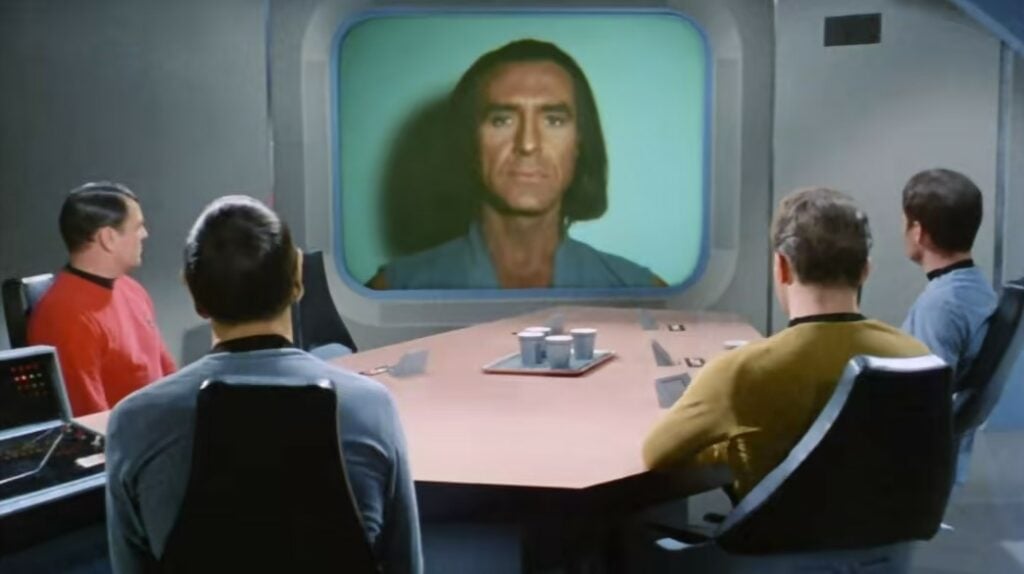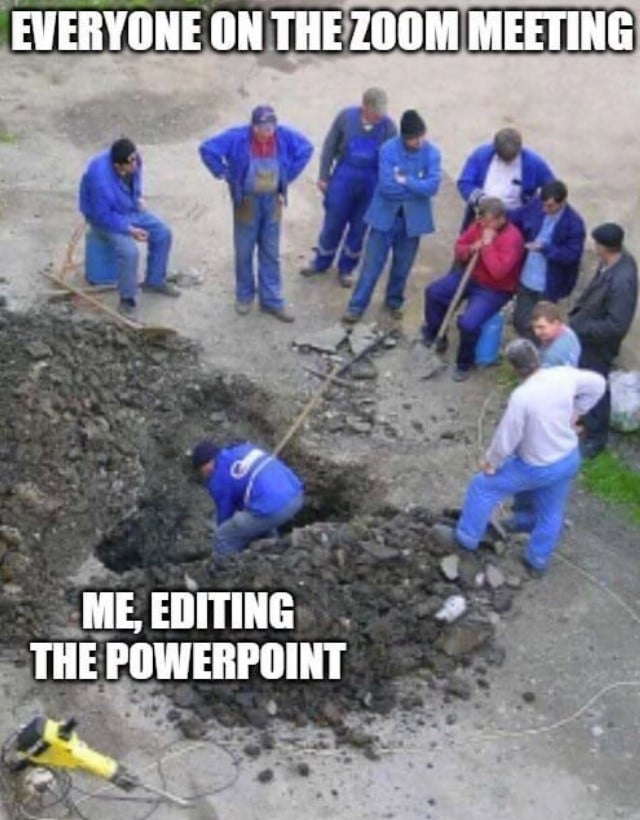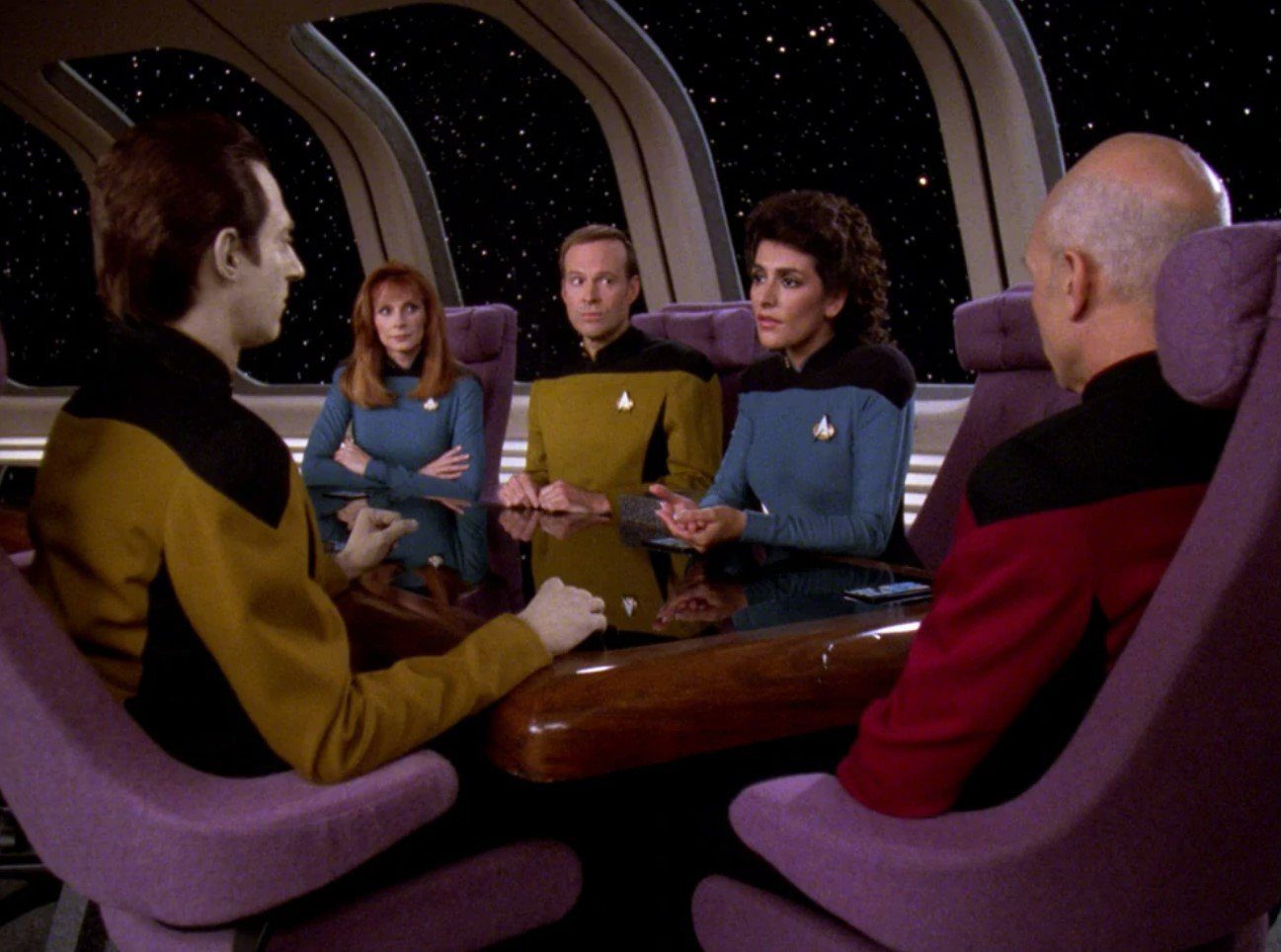Meetings don’t have to be the time-draining, energy-sucking vampires of your professional life. We live in an age of meeting mania, but as a host, you can set a better example. Whether your team is hybrid or remote, these simple tips will keep meetings short, sweet, and efficient.
Federation starships are the ideal workplace. Excluding the ever-present threat of hostile aliens taking host in your colleagues’ bodies, there’s a lot to love. Stylish space uniforms, meal replicators, interplanetary adventures – and of course, effective meetings. In Star Trek, meetings only happen in times of emergencies. Everyone is prepared with their input, and the meeting ends when a decision is reached. The future looks efficient. Thank you, Vulcans!

But what can be done today, if your team’s reliance on meetings is bordering on obsessive? How do we change the dangerous habit of accepting every single meeting invite?
Meetings can be fantastic for brainstorming, decision making, morale boosting, and general discussion. But many companies form an unhealthy dependency on them, accepting back-to-back meetings as the norm. As companies become increasingly remote, the problem is only getting worse. Our calendars are cluttered worse than a grandma’s yard sale. The result? Endless meeting fatigue, job dissatisfaction, and suffered productivity.

Why Have Meetings Become so Ineffective in a Remote and Hybrid World?
In 2020, MIT published a study suggesting only 50% of meeting time is utilized effectively. For anyone who has suffered through a two-hour workshop only to realise 10 minutes were relevant to them, this statistic will come as no surprise. It gets crazier, though. A Harvard Business Review study reveals that 71% of managers feel meetings cost their organization losses in profit and productivity. Yikes. Following the shift to remote and hybrid world, many organizations are having more meetings than ever.
You know what? It’s understandable. If you can no longer run something past Susan while she’s at the water cooler, you’re more likely to pull Susan into a Zoom call. Plus, managers with trust issues may see regular video calls as a way to ensure employees are at their desks (if you are a manager with trust issues, please see a therapist).
But understandable isn’t the same as excusable. All of this means that the average knowledge worker spends around 85% of their time in meetings. Needless to say, this leaves extremely little time to get actual work done. Dangerously enough, meeting fatigue and inefficiency has also shown to have an adverse effect on employees’ psychological well-being.

Tips for Hosting Effective Meetings (Inspired by Vulcans)
- Establish whether the meeting is absolutely necessary.
- Have fewer meetings overall.
- Invite fewer participants.
- Be strict about meeting lengths.
- Prepare – but not excessively.
- Define the objective immediately.
- Share agenda and meeting materials in advance.
- Learn from recorded meetings.
- Stay on track.
- Allow attendees to leave at any time.
- Optimize focus and attention.
- Encourage social talk outside of meetings.
- Keep emotions out of the meeting.
Smooth meetings are not the whole story when it comes to the success of your organization, but they are a significant factor. With YouTube just a click away, and the mute button at our disposal, it’s easier than ever to zone out of a dull meeting.
This means it’s more important than ever to make each meeting count. At tl;dv, remote efficiency is the principle we live and breathe – so here’s a deep-dive on our top tips for running effective meetings.
Wait – do you REALLY need a meeting?
Challenge that inner voice instinctively crying ‘yes’! Meetings are like comfort blankets we throw on when faced with an issue, something unknown, or anything complex. It’s our instinct to call for a meeting every time something new pops up at work. Be that as it may, planning and attending meetings is highly disruptive to ‘deep work’ and ‘flow’.
MIT have coined the term ‘meeting recovery syndrome’ to describe the time wasted directly after a meeting, when attendees feel drained of energy, and struggle to re-immerse themselves in whatever they had been doing before the meeting.
We need to start viewing meetings as exceptions – not the norm.
So ask yourself – ‘is it really worth it?’ Sometimes the answer is ‘yes’ but more often than that, you’ll find a meeting is not as necessary.
Successful adaptation to a remote or hybrid world means finding modern alternatives to meetings. An excellent option is using a screen and voice recorder to quickly show colleagues what you’re working on. Skip the meeting and record a tutorial instead. Once you get used to explaining your input in quick videos, you can start declining invites.
Plus, a two-minute clip is a lot faster to produce and consume than a lengthy wall of text sent over Slack. Speaking of Slack – did you know the platform has its own in-built camera, voice and screen recorder? This is a great alternative to meetings and those dreaded essay-length messages.
The other benefit of short and explanatory videos is that they can be viewed and responded to asynchronously. Next time you want to check or explain something, try doing it through a clip – or even just a voice message.

Have fewer meetings (like, literally half the number)
‘Less is more’. Whoever coined that phrase was definitely talking about meetings. Here’s a challenge worth accepting: try reducing the number of monthly meetings by 50%. Chances are you’ll find the same amount of work gets done (if not more!) and with significantly fewer headaches.
One commonly cited reason for frequent meetings is the difficulty in getting everyone together at the same time. If you can’t collect the whole crew, just have a second meeting – right?
Wrong.
Oh, and everytime a new person gets introduced to a project – let’s have another one-hour introductory session, yeah?
Stahp.
An async approach reduces the need for multiple meetings. By recording meetings and making these recordings accessible to anyone who couldn’t attend, your colleagues can catch up in their own time.
Plus, this helps scale the process of bringing someone new up-to-speed. Simply point them towards essential or educational past meetings. Providing access to a library full of recorded demos, workshops and presentations will ensure the smoothest possible onboarding experience – for the newbie and for you.
Google Meet and Zoom extensions like tl;dv let you timestamp important moments in recorded meetings so you can instantly share the most relevant parts with anyone who couldn’t attend. Over 85% of our users claim this process saves them hours of time. Not bad for a free browser plug-in.

Invite fewer participants
Not only should you host fewer meetings, but you should ask fewer people to attend. Research shows that meetings with more than four attendees pose the risk of someone’s input getting overlooked. Forbes recommend no more than seven attendees. We would put the number much lower – although if you must invite a whole group of people, using anonymous input tools like Menti can help encourage contributions from the quieter types.
After all, big meetings can be intimidating. With so many people in a call, someone is bound to sit silently, uneasy about voicing their input when so much space is already being claimed by the more chatty, domineering types.
Larger meetings are also more chaotic – and failing to give every participant a comfortable environment in which to contribute could cost your organization valuable expertise and insight.
Reduce meeting size, and give everyone the opportunity to have their voice heard.
Be strict about meeting lengths
If we’re sitting in a one-hour meeting regarding a topic that only needs 20 minutes discussion, we’re going to lack the sense of urgency that would otherwise encourage us to stay focused. It doesn’t matter if the topic is ‘shrimp’ – if the meeting is one hour, attendees will find a way to talk about shrimp for one hour. It’s a truly fascinating phenomenon of work life.
Organization psychologist Steven Rogelberg is known for his book on helping teams reach ‘peak performance’. His biggest tip for improving meeting quality is simple: keep it brief.
Marissa Mayer, Yahoo’s CEO, will only attend meetings that last no longer than ten minutes. When we make meetings shorter, we encourage attendees to cover more ground in less time.
In other words, a short and snappy meeting ensures we get to the point. Meetings should rarely exceed thirty minutes.
In the exceptional cases when a meeting has to be longer than an hour – make sure that there are breaks. Encourage attendees to stand up and stretch, make some tea, scream out of a window, or do something else relaxing for a few moments. They’ll return to the call refreshed and thankful.
Prepare (but not excessively)
The meeting itself isn’t the only time-waster. Hours slip away while we prepare for them, too. Then again, an ill-prepared meeting will see you turn red in the face, as you panickily search for the right PDF from your Downloads during screen share, hoping no one noticed that file entitled ryan-gosling-holding-puppy.jpg

Getting the balance right is key. You want to feel confident going into the meeting, with all your presentational material ready and loaded on your screen. At the same time – don’t overthink it. Entering a meeting with a very rigid idea of how the discussion should progress could stifle creativity. Allow for a little spontaneity – especially in workshops and other creative sessions.
Define the objective immediately
Effective meetings should center on a specific objective, such as
a) learning something together
b) solving problems
c) sharing updates
d) brainstorming
Knowing the precise focus and desired outcome of the meeting is the first step. As a host, you’re responsible for circling back to the objective at regular intervals to ensure the discussion stays on track.
Share agenda and materials beforehand
Hosting a meeting without an agenda is like turning up to a kayak race without an oar. You’re not going to get very far.
The agenda does more than define the objective – it gives clear pointers as to how much time participants should spend on each subpoint. It gives invitees a better idea of whether their attendance is really necessary – and if so, they’ll see more or less when in the call they might want to contribute.
When allocating time for the different bullet points of an agenda, always factor in a few extra minutes for additional discussion time. If a discussion exceeds the allocated time, make a timestamp to revisit it (we recommend a timestamping tool like tl;dv). You can then easily revisit the non-concluded topics at a different time.
Similarly, it’s a good idea to share reports, slides or other presentational materials in advance, to allow invitees the opportunity to get more acquainted with the topic before the call. Give everyone who is unable to attend the call a snapshot of what will be presented.
Learn from recorded meetings
If your meetings are in the business of getting derailed and you don’t know why, why not revisit the call to analyze its focus and progression? Approaching a past meeting with the mindset of ‘what went well?’ and ‘what could have been better?’ is a great way to gain insights that can be applied going forwards.
You may find one attendee was regularly talked over. Possibly you’ll notice Steven was totally unprepared and spent five minutes fumbling with his PowerPoint presentation. Were there moments that dragged? Did the call get concluded in a timely, actionable manner? Did a terrible internet connection slow things down? Identifying the common culprits to ineffective meetings is the first step toward eradicating them.
Park that thought
Sometimes a fantastic idea is raised in a meeting which, though totally irrelevant to the agenda, needs further examination. As a host, you should be able to identify when the meeting takes an unexpected (but potentially valuable) turn, and make a decision on whether to step outside of the agenda for a moment, or ‘park’ that topic for another time. If you do end up parking an important topic, make sure to timestamp or highlight the moment in the call,
Tell attendees they can leave when they want
Why is it such a taboo to say ‘this meeting is no longer relevant to me, I’m jumping off’? If you find yourself trapped in a meeting you’ve realized is not going to help you with your job, simply leave.
A corporate leader once impressed me by immediately identifying that two employees who had been needlessly dragged into the meeting. She invited them to leave, just two minutes into the call. With that simple action, two employees won back an hour of their time that would have otherwise gone totally wasted.
Even Elon Musk once said: “Walk out of a meeting or drop off a call as soon as it is obvious you aren’t adding value. It is not rude to leave, it is rude to make someone stay and waste their time.”
Sometimes that anime-loving, psychedelic-dropping, egomaniac billionaire actually has something relevant to say after all.
Optimize focus and attention
No multitasking. Cameras on. Phones out of reach. These ground rules apply to both hosts and invitees – and while such principles shouldn’t be enforced, communicating them regularly as ‘meeting goals’ will encourage more people to adopt them over time.
Ultimately, they’re not so much ‘ground rules’ as ‘tips for focusing’. Many meeting attendees openly struggle with their attention spans, so some attendees may genuinely appreciate the host starting the call with a quick reminder of the ‘focus tips’.
As a host, it’s also your responsibility to ensure the meeting is engaging. Switching between formats (like hopping from Miro to Menti) can be a great way of keeping attendees’ attention. Other than that, remind everyone that they’ve been invited because their participation is genuinely needed.

Encourage social talks outside of meetings
Hybrid and remote work does get lonely. Particularly for extroverts, meetings provide a much-needed opportunity to talk face-to-face with other human beings. It’s difficult to resist talking about the latest shows on Netflix, or the fact that Susan has a new cat.
To be clear, social chit-chat (even gossip, apparently!) among team members can strengthen relationships. Simply sharing a few jokes can improve feelings of connectedness, while boosting collaboration and overall well-being. That being said – there’s a time and a place for Netflix and cat talk.

By formally designating different times of the week for casual non-work chats, your team can get their social fix outside of meeting time, increasing the likelihood of everyone sticking to the agenda in actual meetings (an agenda which, sadly, does not include Susan’s cat).
Passionate debates are great – until they aren’t
Every so often, a meeting takes an emotional turn. Picture it: Gary wants to change the font of ‘Contact Us’ button from Arial to Verdana, but Susan insists the font is fine as it is. A third meeting attendee raises the stakes by claiming the ideal font is in fact Comic Sans. The fourth attendee just looks intensely awkward.
A bit of lively discussion from time to time is a sign of passionate, engaged employees who stand by what they believe, and want the best for their team. Even a heated debate can be beneficial, because it addresses topics that people obviously feel strongly about.
But when a debate risks turning into a tense argument in which one or more people are likely to get upset, the call is no longer productive. Meetings that are likely to become emotional include feedback sessions, HR matters, and reviews of unsuccessful campaigns.
Certain topics are simply not best addressed in a recorded meeting of multiple attendees – so step in and moderate before emotions run too high. Let the air cool between colleagues before approaching the topic again.
Are you ready to master the art of an effective meeting? If you find unproductive habits persist, just remember the most important principles – keep it short, invite fewer attendees, write a kickass agenda, go in with clear objectives, record and timestamp the moments that matter. We guarantee following these simple tips will transform your meeting culture into a healthy one, making every call count and saving tons of time for everyone.





